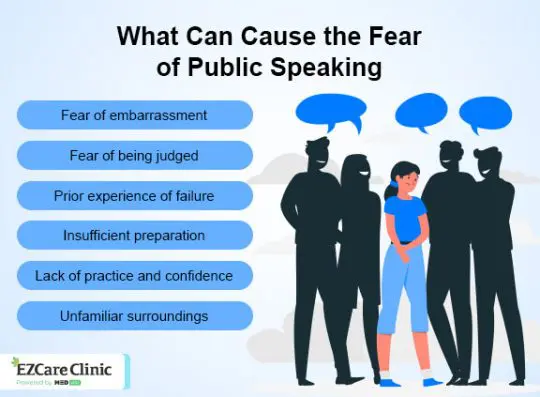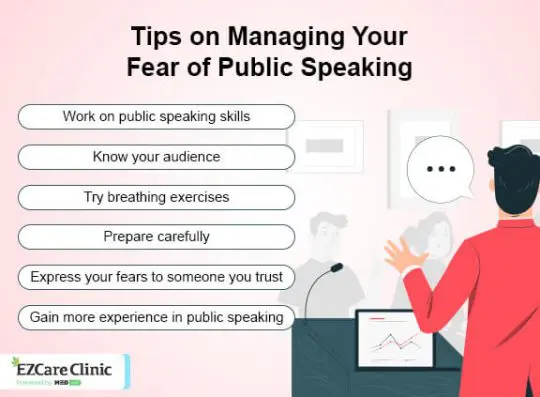Fear of public speaking, or glossophobia, is a common form of anxiety. Glossophobia goes beyond occasional nervousness or worrying about being in front of an audience. For those affected, speaking in public can trigger full-on panic and fear, sometimes to the point of a nervous breakdown. A person may experience uncontrollable trembling, sweating, and increased heartbeat. Strong fears may also give one an overwhelming urge to run out of the room.
While it’s often not possible to completely eliminate glossophobia, there are ways to manage and reduce it.
Anxiety can be managed effectively. Ask our doctors how to reduce the symptoms.
What Causes Fear of Public Speaking?
While the specific causes of phobias are still unknown, glossophobia may be instigated by biological, genetic, environmental, or psychological factors. Getting to the root of your anxiety may help you take effective steps to deal with it. Here are some of the reasons people have a strong fear of speaking in front of a group:
- Fear of appearing nervous
- Self-consciousness
- Poor or insufficient preparation
- Past failures of public speaking
- Fear of being judged
- Underestimating your abilities
- Not feeling comfortable with your body
The brains of people with social phobias have a
Fear of public speaking is not confined to speaking to larger audiences. Individuals may struggle to speak in a classroom, meeting, or other smaller group settings. A person may not be able to clearly express their ideas and thoughts. This may hamper their career, social, or academic opportunities.
Signs and Symptoms of Public Speaking Anxiety
Glossophobia may manifest differently depending on the individual. Common symptoms of fear of public speaking may include:
- Increased heart rate
- Sweating
- Difficulty breathing
- Shaking
- Muscle tension
- Feeling flushed
- Nausea
- Dry mouth
- Headache
- Urge to get away
Statistics on the Prevalence of Fear of Public Speaking
Fear of public speaking is a
Public speaking anxiety accounts for 17% of the general population. Also, fear of public speaking is present in

How to Get Over Fear of Public Speaking
Know Your Audience
One of the most common mistakes people make when preparing for a presentation is starting with the topic and focusing on the details. As such, it becomes harder to have a connection with the audience. Before getting into details, it’s important to ask yourself the following questions:
- Who will be in the room?
- What do they need?
- Why are they there?
Be sure to provide specific answers to these questions. Then, create a message that directly addresses the specific needs of your audience.
The fear of speaking in public is widespread, but it doesn’t mean you have to be one of those suffering from it.
Practice, and Then Practice Some More
You need to practice your presentation over and over again. Employing visualization techniques can help boost your confidence and allow you to refine what you want to say. You can present to family or friends, use a virtual reality app, practice in a video conferencing simulator, or join your local Toastmasters club.
Also, consider practicing in front of a mirror or making a video of your presentation. Pay attention to gestures, facial expressions, and body movements. Make notes of how you could make your presentation better.
Know Your Content
The better you understand what you’re talking about, the less worried or anxious you will feel. Also, knowing your topic inside and out reduces the likelihood that you’ll make a mistake or get off track. Take time to consider every potential question you may get from the audience and have your responses ready.
Take Note of Significant Points
Because of anxiety, you may be enticed to write out your speech in full and read the words verbatim from a piece of paper. However, you’ll sound stiff if you’re reading from a prepared script instead of addressing your audience directly.
Carefully plan out the information, taking note of your key points. Use any props, index cards, and audio or visual aids to remember your big ideas and stay on track. The more organized you are, the less nervous you will be.
Take Some Deep Breaths
Sometimes, we tend to ramble when speaking. Taking deep breaths is an effective way to manage fear and talk at a pace your audience can keep up with. Take some deep breaths before you get up on the podium and at appropriate times during the presentation.

Focus on the Message
There will always be someone in the audience looking tired, yawning, or using their phone. Don’t let them distract you because their mood has nothing to do with you personally. Get out of your head and focus on delivering your story or conveying your message.
Bottom Line
Dealing with the fear of public speaking will open you up to another world of possibilities. If these tips are ineffective despite repeated attempts, consider seeking professional help for proper evaluation of your condition and treatment accordingly. Anxiety may require medications, cognitive-behavioral therapy, or a combination of the two.
Sources
- The biology of fear- and anxiety-related behaviors. (2002)
Source link - The relation between public speaking anxiety and social anxiety: a review. (2009)
Source link - Specific phobias. (2020)
Source link - Observations: Public Speaking Anxiety in Graduate Medical EducationâA Matter of Interpersonal and Communication Skills? (2016)
Source link - Epidemiology of social phobia: a clinical approach. (2000)
Source link



